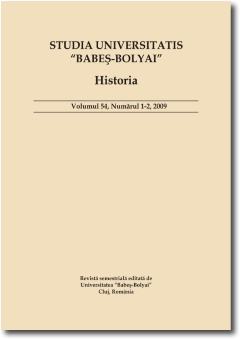ARMATĂ ŞI LIMES ÎN DACIA ROMANĂ
ARMY AND LIMES IN ROMAN DACIA
Author(s): Eduard NemethSubject(s): History
Published by: Studia Universitatis Babes-Bolyai
Keywords: Roman Dacia; Banat; Roman army; limes; Roman roads;
Summary/Abstract: The wider notions of army and limes, which were tightly linked to each other in the Roman Empire, are here examined from the view point of their specific forms in the Roman province of Dacia. Starting from a very useful study by B. Isaac on the meaning of the terms limes and limitanei (Isaac 1988), the author investigates the layout of the major Roman roads from Dacia that linked the main fortresses of the occupation army. He came thus to the conclusion that most major Roman roads ran in a north-south direction, so they were most probably limites in a sense from the time of the Early Principate, i.e. military roads towards the enemy’s territory. Thus the layout of the major roads from Roman Dacia was already set during the Dacian Wars of the Emperor Trajan (101/102 and 105/106 AD). After the Roman province was established and also after the important reshaping of the Roman territories in the north of Danube made by Emperor Hadrian, the layout of the roads remained roughly unchanged. Some of the wartime fortresses have been abandoned and other were built, in many cases very near to the former, which sometimes leaves the impression of “double forts”. Some of the roads became beginning with the reign of Hadrian limites in the sense of land frontiers (e. g. the so-called “Limes Transalutanus” at the border of south-eastern Dacia or the road that linked the fortresses from the north-eastern frontier). Not as simple to define as that is the western frontier line of the province. There is an apparent lack of fortresses (except the very scarcely known small camps from the gold district in the Apuseni-Mountains) southward from the one in Bologa (see map) to the one in Micia, on the Mures river. Also the southwestern borderline of Dacia has been subject of debates; some scholars designated both lower Mures and Tisza rivers as the frontier. The author argues against this theory, mainly because of the lack of Roman remains on the lower Tisza, while those on the lower Mures were merely from vexillations that guarded the shortest road between Dacia and Pannonia. Another argument is that the region enclosed by the lower course of these two rivers was mostly a swampy one, where neither Roman towns nor forts have been built. Since the forts on the road between Banatska Palanka and Berzovia seem – according to the archaeological results – to have been abandoned by the army at the beginning of Hadrian’s reign, it is possible that at least one of the great earth ramparts to the West of Dacia has been built to be the visible frontier line of the Roman province, so that maybe not all these ramparts were erected only in the 4th century AD, as it is usually assumed.
Journal: Studia Universitatis Babes-Bolyai - Historia
- Issue Year: 54/2009
- Issue No: 1-2
- Page Range: 100-110
- Page Count: 11
- Language: Romanian

